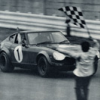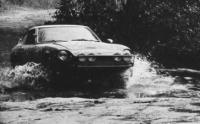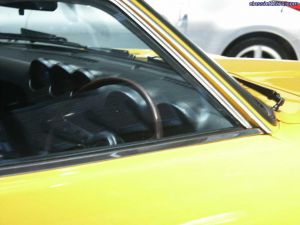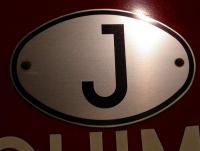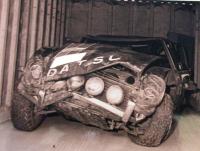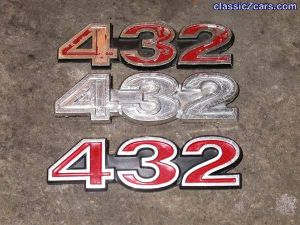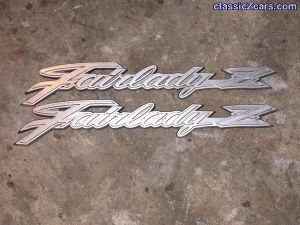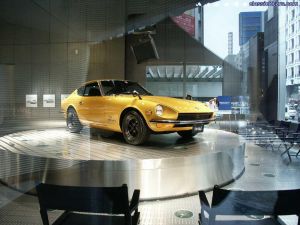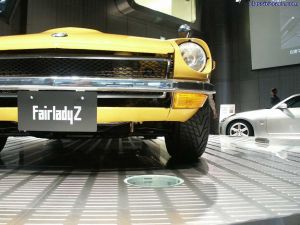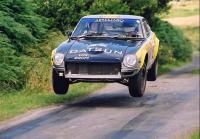Everything posted by HS30-H
-
Rally du Bandama 1973
Hi Guus, That's an interesting photo! The only photo I have seen of the Mehta / Billstam 1973 Bandama Rally Z shows slightly different details. Biggest difference is that in your poster photo the Cibie Oscars on the front of the bonnet are very easy to spot. On the ( black and white - and not so clear ) photo that I have seen, these lamps are just not there. I can't quite make out the race number on the door of the car in the black and white photo - but it looks different. The front spot lamps ( four of them ) look like they are higher ( behind the cow catcher ) and spread out further. I guess there is a great possibility that they could have moved the lamps during the rally. Maybe because of damage or function issues? I'm wondering whether these photos are of the same car on the same event, or of the same car on different events, or of different cars on the same event, or of different cars on different events. My head hurts.:stupid: Alan T.
-
Urgent non related Z content
OK Fred - since you invited me.............:cheeky: I don't understand about the word "offer" in the phrase. What is on offer? Who is offering? Anyone looking at that page already knows that they are there to have something offered to them. No? If I were a customer who was looking for the logistics services of this company, then I would have thought the phrase "Our logistics will move you" or "Our logistics services will move you" would be a nice pun that still gets the point across. But then, as an Englishman, what would I know about English? Alan T.
-
Looking for the J (apan) county plate
Go for it Guus, I'm sure you can make a really accurate replica. You should be able to gauge the size and shape from referencing your pics and mine. The aluminium plate is quite thick ( maybe 1.5mm? ) and not as thin and easy to bend as you might think. I'm sure you can buy sheets of the silvery-white reflective background to stick on it, and the black border and letter are probably easy to get computer-cut and carefully stuck on. Bury it at the bottom of your garden for a few months and then dig it up. A quick wipe, and it'll look just like the real thing!:classic: Alan T.
-
240z engine rebuild options
Hi Andrew, Ah, Bournemouth. The English Riviera. I've had some good times down there. Its a bit closer than 3000 miles that's for sure! I've always found that the Bournemouth and Poole area had a real lot of serious car freaks. Lots of really good Rods and Rod builders. Is Dorset the British California?!........... I can understand your sentiments for wanting to keep the original engine in the car if possible. Its such an early car ( in comparison to the average UK car ) that it has to be worth thinking along these lines. However, you can still pep it up a little and have something that's very satisfying to drive but still tractable and relatively docile. I always think that its worth taking advantage of this country's so-far lenient laws with regard to modification of old cars. This will free up your options on the spec. of the engine. I'll PM you my direct e-mail address and we can take it further. I'm sure I have some parts that you might be able to find a use for. All the best, Alan T.
-
240z engine rebuild options
Hi abas, I'm based in central London - so a little closer to you than most of the people that frequent this site! Maybe that will be useful. If you are determined to save the original L24 block that came with your early car, then Steve's ( sjcurtis ) advice to have the damage assessed by a professional machine shop is going to be the only way to go. I don't think you can do anything with it until you know where you stand. Maybe its beyond saving already. Alternatively, I have just about all the parts you would need to build up either an L24 or L28 engine. I have blocks, cranks, rods, pistons and cylinder heads. I have these items in component form as well as assembled heads and short blocks. Once you decide what route you want to take, then I can possibly help you out with any mechanical parts that you might need. Going for a fairly peppy L28 build up might not be as difficult or expensive as you think. All the machining work you might need, as well as the cost of the rebuild parts like bearings, gaskets and piston rings etc are going to cost just about the same whether you are building an L28 or an L24. I've even got some good used and new performance parts that you might want to spice it up with. I think the hardest part for you is just deciding which way you want to go. However, most mechanical installations can be reversed - so you could take the car back to a more original spec in the future if you wanted. Body, paint and trim are slightly different in that respect. Good luck! Alan T.
-
Fairlady Z 432 - Fairlady Z (33) in background
This car would have had the same spec. steering wheel as the other models ( the plastic / wood composite one ). It would not have had the "Datsun Compe" steering wheel unless a previous owner or the current owner fitted it himself. Difficult to call with the question regarding holes or non-holes in the steering wheel spokes for this car. The 432's had a very strange production process, with some cars being part-built one year and then finished off in another. They sometimes show signs of being earlier or later than their details would indicate, and they are notoriously difficult to date from pictures. Of course, the current steering wheel might have been put on after the original was damaged or lost anyway...............
-
fender mt mirror question
I'll down it in one! The next one's on me. :classic: Alan T.
-
fender mt mirror question
Thanks Chris, It makes it a pleasure if people like yourself appreciate the effort and can use the data / information to good effect. I only wish that the people who ask the original questions might sometimes be bothered to acknowledge that somebody attempted to give answering them a full and proper shot. Declining social skills, maybe? It would be a real shame if this site ended up like a lot of the car-related sites on the web. Sometimes I read them and start to think that people don't even notice when they have their cake and are eating it. What say you, 1975yellowBSPZ? Alan T.
-
Looking for the J (apan) county plate
-
Looking for the J (apan) county plate
whoops
-
Looking for the J (apan) county plate
Here's another angle:
-
Looking for the J (apan) county plate
Hi Guus, Your best bet is to make a replica yourself. The originals are VERY rare even in Japan ( not many Japanese-registered cars were fitted with them for 'temporary use' outside Japan, in conjunction with the 'temporary export' translated Japanese registration number plates ) - so I think you will be very lucky to find one. Making a replica should not be too difficult. The originals were just aluminium plates with a white reflective face ( you know - the type that looks white until you shine a light at it, and then it becomes reflective ). On top of that, they screen-printed the black border and "J" letter. You could do it with computer-cut vinyl lettering. They just pop-rivetted them to the rear hatch ( using steel pop-rivets, not aluminium! ). Its just a flat piece of metal - no moulding / forming at all. Here's a pic for better reference: Alan T.
-
fender mt mirror question
Oh well - maybe the information will be of use to somebody else who will appreciate it.................................. Alan T.
-
g-nose years
Constantly over 100mph? Where does he live then - Daytona? If his "authentic" G-Nose is strengthened or reinforced then he might not have the same drooping issues. However - I can assure you that this is a well-known problem amongst owners of the real thing in Japan. Its not just my car that does it. Alan T.
-
interesting rally photo of 240z
Hi Guus, I can see the flaps - but I think they were almost certainly fabricated from scratch and fitted by the owner / preparer of the car. The reason I say that is because the front splash-flaps seen on the Works-built Safari Rally cars were actually never available as a Sports Option or race part from Nissan. The ones on the Safari cars were hand-made in Japan by the craftsmen who prepared the cars, and by the Works mechanics who travelled with the cars to Kenya. They gradually developed them to be even bigger during testing / practice to help stop mud and water splashing up and over the front of the car when they forded the many rivers and streams on the rally. The rear mud flaps ( with "Datsun" in white writing on them ) WERE offered as a Sports Option part - so their situation is slightly different. However, even these had hand-fabricated mounts on the Works cars. My opinion is that the owner / preparer of the Portuguese car may have seen pictures of the Safari cars, or even developed his own parts without seeing the Safari cars, to cure the same problem. Surely if there was at least evidence of ONE type of Works part or Sports Option part on the car, then he would have had more? We don't know about the engine and drivetrain parts - but I'm willing to bet that they were very close to stock, or had some 'local' tweaks. Alan T.
-
interesting rally photo of 240z
Ben, I suggested that you ask Guus because he is collecting and classifying 'Privateer' as well as 'Works' cars on his "Victory Lane" table of results. For my part, I've been limiting my own parameters to 'Works' or 'ex-Works' / 'Works supported' cars. The only exception is Japanese circuit racing, where lots of other interesting stuff went on and lots of privateer teams got hold of ex-Works parts and ex-Works parts. What I can tell you about your picture of the Portuguese-registered rally car is that it is almost certainly a Privateer car and has no evidence ( from the pic ) of Works or Sports Option parts on it. Even the lights are CIBIE Oscars ( as opposed to Koito ) and it appears to be on stock-looking steel rims. It bears all the hallmarks of a private entry car with a few tweaks to help it on the stages. There were many cars like this around in the early Seventies. Most of them seem to be relatively undocumented in racing history, and you have to go back to search entry lists and results for the events to find out anything about them. Its a shame that we can't hear their stories. The picture that Mr Camouflage posted is of an entirely different animal. The pic shows Harry Kallstrom and Claes Billstam taking part in the 1973 RAC Rally, and I think this picture was taken on one of the Welsh stages of the rally. This is a full-blown Works car, and was registered "TKS 33 SU 4079". This particular car was running some pretty trick parts for the time, and was just about the ultimate Works rally development of the 240Z before they switched over to the 260Z. It was running the "LY" Crossflow engine with ECGI fuel Injection, and would have been a very fast car. You can see it is using the homologated bumper with the lowered centre section ( nicknamed the "Drop" or "Monte Carlo" bumper ) which was first used on the 1972 Monte Carlo Rally. The lowered centre section allowed better placement of the spotlamps ( better for cooling, better for light beam spread and better for protection ) and this type of bumper was seen on many of the later Works rally cars. Don't get confused about the front valance corners and indicator lamps of this particular car. In fact "4079" was almost certainly first fitted with the usual wraparound indicator lenses and front valance corners when it left Japan. However, these were very vulnerable on the stages - and were often broken. This loses points in certain rallies, and I should imagine that they were either replaced with the UK-type after the originals were damaged, or the staff at the UK-base for the Works team ( Old Woking Service Station ) fitted them to avoid inevitable damage to the originals before the car started the 73 RAC. Don't forget that the fact that our UK-market cars had the different valance corners and indicators meant both that the 'proper' wraparound types - generally fitted to the Works rally cars - would have been in short supply here, and that there may have been issues with using lighting / indicators that did not comply with UK Type Approval regulations ( which is why the UK market cars did not have them in the first place ). Nothing is simple when it comes to the Works rally cars. Nissan built more than 50 of them, and each one had its own spec. and its own life. All the best, Alan T. ( PS - this is what happened to a lot of them: )
-
g-nose years
Just to clarify Gav, It was only the actual Bumper of the ZG and the Factory G-Nose kit that was made from Urethane. All the other parts ( Headlamp cowls, upper panel, lower panel & Overfenders ) were made from fibreglass ( "FRP" in Japan ). There would be nothing wrong with the replicas if they were even close to the quality and fit of the original parts - but they usually are not. The best of the budget replicas I have seen were made in Japan, and once properly installed look like the real thing until you get close enough to look underneath. However, I have seen replica panels made by a one-man company in Japan that are all but indistinguishable from the real thing. The same company even replicates the Urethane front bumper perfectly. He only supplies these to owners of original ZG's who need them to repair crash damage, and they are VERY expensive. The original items are extremely good quality, but even then there can be fit issues. Once you get the car up to a high speed ( over 100mph ) it starts putting a BIG strain on the panels, and they are after all basically just hanging off the front of the car with not very much holding them up. I've stopped after some fast motorway and track drives to find that the bonnet filler panel has drooped about 1cm. Wait about 10 minutes and it gradually seems to 'relax' back into shape................. Don't forget that the Bonnet / Hood hinges are also different. Alan T.
-
Nismo front grill
The original finish was a metallic gunmetal grey I believe. I think the new ( OEM ) ones you can buy are in this finish too? I've seen the 432-R type on real PZR's in Japan, and the ones I saw were satin black. I believe they were this colour originally - but I'm not 100% sure. I have conflicting reports on that point, and I think the colour may have been changed at some point. My guess is that satin or matt black was too difficult to keep looking clean without constant repainting ( ? ). When I fitted a ( new ) mesh grille on my old everyday driver - the red UK-market HS30 that I turned into a Fairlady 240Z replica - the grille didn't last longer than a few months before getting rust spots on it. They really do have very little paint on them, and what little there is soon gets blasted off by road grit! Of course I live in foggy and rainy old London town - so maybe that had a lot to do with it. Anyhow I'd recommend a thicker and more thorough paint job to anybody buying a new one. A couple of rattle-cans should do the job. Alan T.
-
Nismo front grill
Just a quick point of clarification before this thread turns into history..... What is being referred to here as a "NISMO Grille" has nothing to do with NISMO at all. It is also not specific to the 432 model. The 432 front grille ( original part number 62300-E4101 ) was exactly the same as that fitted to the Fairlady Z, Fairlady Z-L, Fairlady 240Z and Fairlady 240Z-L models for the Japanese market. All those models shared the same part number. The 432-R model however had its own unique grille ( original part number 62300-E7200 ) and the main difference was that it had a different gauge of mesh. The replacement Japanese-market model grilles that can still be bought today are the modern version ( OEM remake ) 'normal' versions - not the 432-R type.:classic: Alan T. ( nit picking department )
-
Pot metal emblems
From the album: Fairlady Z432-R replica project
Original 'Pot Metal' 432 emblems. Three stages of restoration. -
Pot metal emblems
From the album: Fairlady Z432-R replica project
Original 'Pot Metal' Fairlady Z emblems - stripped for repaint. -
Fairlady 432 in the window
The sheetmetal on the 432 is no thinner than on any 'normal' early S30-series Z. It was the 432-R that had different part numbers for thicker and thinner sheetmetal parts compared to the other cars. I doubt that this car has seen any track action in its life, and the closest it has come to a race track would probably be in the public car park on a race day. Generally speaking, most street 432's in Japan stayed as street cars, and most race cars ( especially race 432-R's ) stayed as race cars all their lives and died doing it. Any body damage / patina you saw will almost certainly be attributable to 33 or so years of street 'life' in Japan.
-
Fairlady Z 432 - Fairlady Z (33) in background
That "strange cylinder" behind the grille is the radiator overflow bottle. All the 432 and 432-R's were fitted with these.
-
11th Classic SLS Rally
Yes - he was certainly looking apprehensive about "touch down"! With his current gearing and tyre size, at peak RPM in 5th gear, he would have been at around 120mph or more when the picture was taken.:cross-eye Unfortunately, a couple of corners later he went off the road and into a ditch. That's rallying for you. Not much margin for error, and quite serious damage for a slight off.............. I certainly hope you don't take it so seriously in your car. Its too nice to bend! All the best, Alan T.
-
11th Classic SLS Rally
Hi Guus, Great to see that you are using your car in this kind of event. Well done! Thought you might like to see this photo that I received recently. The driver has a funny expression on his face. Apparently he was flat-out in 5th when the picture was taken........... All the best! Alan T.




